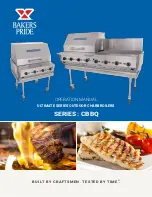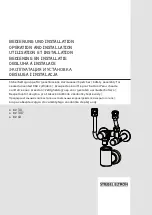
19
POOL HEATING
The ADB unit is equipped with an external pump and
bypass arrangement that blends outlet water with the
inlet to increase the inlet water temperature, thereby
reducing the likelihood of condensation forming on the
heat exchanger. The pump also serves to circulate
water through the heater form the main system piping.
To complete the installation of the pool heater, the pool
thermostat needs to be installed in the main return
water line. This will ensure that the heater will be ener-
gized at the right time. If the main water line is too far
away from the heater and the capillary bulb will not
reach it, locate the pool thermostat adjacent to the
main line and run wires back to the heater. See Figure
13 and 14.
Adjustment of the bypass valve is critical to proper
operation of the heater. The bypass valve should be
adjusted to achieve a minimum inlet water tempera-
ture of 105°F and an outlet water temperature of
125°F. When starting with a cold pool, make initial
adjustments. Make final adjustments when pool water
approaches desired temperature. Refer to Table G for
flow rates.
CAUTION:
Power to the heater should be
interlocked with the main system pump to make sure
the heater does not fire without the main system
pump in operation. Improper flow control can
damage the heater. Uncontrolled flow (too high) or
restricted flow (too low) can seriously affect heater
operation. Follow these instructions to make sure
your heater is properly installed.
Table G: Flow Rates
*Loop is secondary piping to heater from main system
CAUTION:
ADB bypass piping should be copper
and/or CPVC. PVC piping should NOT be used.
Automatic Chlorinators and
Chemical Feeders
All chemicals must be introduced and completely dilut-
ed into the pool or spa water before being circulated
through the heater. Do not place chlorine tablets or
bromine sticks in the skimmer. High chemical concen-
trations will result when the pump is not running (i.e.
overnight).
Chlorinators must feed downstream of the heater and
have an anti-siphoning device to prevent chemical
backup into the heater when the pump is shut off.
Winterizing Your Heater
When heaters installed outdoors in freezing climate
areas are to be shut down for the winter, please
observe the following procedure:
1. Turn off manual main gas and main gas shut off.
Remove the drain plug or open the drain valves
located on the bottom header.
Pool and Spa Water Chemistry
NOTE:
High chemical concentrates from feeders
and chlorinators that are out of adjustment will cause
very rapid corrosion to the heat exchanger in the
heater. Such damage is not covered under the
warranty.
NOTE:
Chemical imbalance can cause severe
damage to your heater and associated equipment.
Maintain your water pH between 7.4 and 7.8 and
total alkalinity between 100 and 150 p.p.m. If the
mineral content and dissolved solids in the water
become too high, scale forms inside the heat
exchanger tubes, reducing heater efficiency and also
damaging the heater (max TDS at 3000 ppm). If the
pH drops below 7.2, the heater will be severely
damaged.
NOTE:
Heat exchanger damage resulting from
chemical imbalance is not covered under the
warranty.
Содержание 751
Страница 2: ...2...
Страница 6: ...6 Component Locations Fig 1 Component Locations...
Страница 14: ...14 Fig 4 Single Boiler Primary Secondary Piping Fig 5 Single Boiler Primary Secondary Piping with CHX...
Страница 15: ...15 Fig 6 Dual Boiler Piping Fig 7 Dual Boiler Piping with CHX...
Страница 20: ...20 Fig 13 Single Boiler Pool Application Fig 14 Single Boiler Pool Application with CHX...
Страница 44: ...44 Figure L 2 WIRING DIAGRAM WIRING DIAGRAM...
















































